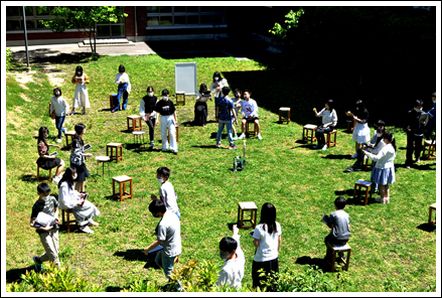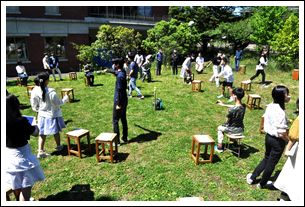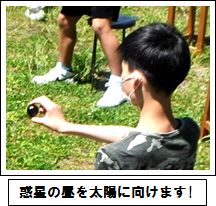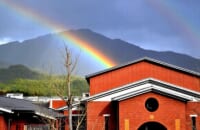
星座をつくる恒星とは異なり、惑星という地球の仲間の星々は、太陽と地球とその星の位置関係で見え方がいろいろ変化します。
今回、2年生「理科Ⅱ」の授業では、その現象を開放空間で身をもって体験するという貴重な体験を実施しました。
 中央で輝く電球は「太陽」です。地球の内側には金星の軌道、外側には火星の軌道があります。各グル-プのリ-ダ-が地球人となり、同じグル-プのメンバ-が金星人、火星人となってそれぞれの指定の場所につきます。そして、それぞれの場所から見える惑星の大きさ、形に注目するのです。まず「月の満ち欠け」のように自ら光を出さない惑星の見え方を地球人が確認します。さらに、「金星人からみた地球」、「火星人からみた地球」という現時点ではありえない設定で考え、それぞれの惑星の見え方を観察してみようというねらいです。
中央で輝く電球は「太陽」です。地球の内側には金星の軌道、外側には火星の軌道があります。各グル-プのリ-ダ-が地球人となり、同じグル-プのメンバ-が金星人、火星人となってそれぞれの指定の場所につきます。そして、それぞれの場所から見える惑星の大きさ、形に注目するのです。まず「月の満ち欠け」のように自ら光を出さない惑星の見え方を地球人が確認します。さらに、「金星人からみた地球」、「火星人からみた地球」という現時点ではありえない設定で考え、それぞれの惑星の見え方を観察してみようというねらいです。
 生徒のみなさんは適宜位置を変えて、12か月のそれぞれの見え方をiPadなどで記録する必要があり、とても忙しそうです。
生徒のみなさんは適宜位置を変えて、12か月のそれぞれの見え方をiPadなどで記録する必要があり、とても忙しそうです。
このように、自分自身が動き、想定した宇宙空間の中で自由に考え、そしてリ-ダ-の的確な指示力が問われる動的な学びから、真の天体現象の理解に接近してくれれば、とても嬉しいことです。
Unlike the fixed stars that make up zodiac signs, the planets that are in the same category as our Earth can change their way of being viewed depending on their position in relation to the Sun and the Earth.
In our Science class, we were able to experience this very special phenomenon in an open space outdoors.
The light bulb in the middle is the Sun. We made the orbit of Venus on the inside of the Earth, and the orbit of Mars on the outside. The leader of each group was from Earth, and the other members of the group were either from Venus or Mars and they stayed in their designated positions. From these positions, they viewed the planets, taking note of their size and shape. First, the people on Earth checked the views of the planets, which don’t emit light, as if they were watching the phases of the Moon. Then they were asked to think about how the Earth is viewed from Venus or from Mars, something that is usually impossible, and observe each or these viewpoints.
The students had to change their normal position of definition and record these observations for the 12 months of the year, so they were quite busy. By doing this, they were able to move and think freely within their assumptions about outer space. Hopefully, they were also able to learn about a real celestial phenomenon by following and learning from the instructions of their leaders.
《Words》星座 zodiac signs、太陽系 Solor system、恒星 fixed star、惑星 planet、軌道 orbit、月の満ち欠け the phases of the Moon、天体現象 celestial phenomenon、仮定・想定 assumption



